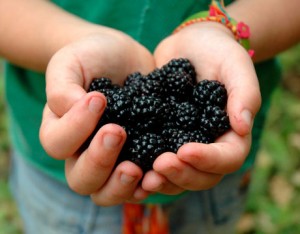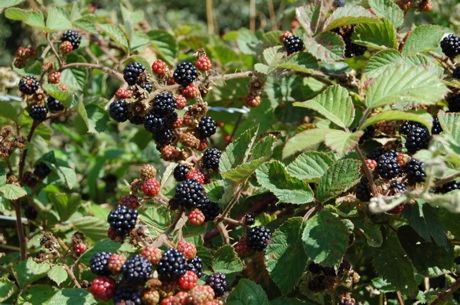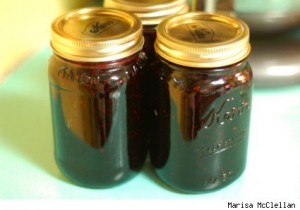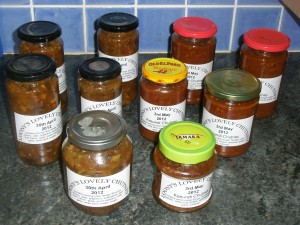When I was a child, autumn was the season for blackberry picking. My mother would take us to the waste ground down by the railway line, and we would spend the afternoon with our buckets and bowls, hunting out the best bramble patches with the biggest, juiciest blackberries. We would trample our way into the thickets, trying not to get our legs scratched to pieces, reaching in as far as we could to get every last ripe berry.
Another favourite location was a place called Otterham Quay. There were so many brambles that we were totally spoilt for choice, and we used to have to shout to each other to make sure that nobody got lost. By the end of the day, we would be filthy dirty, our hands and arms would be scratched, sticky, stained deep purply red, and our legs would be a mess of scratches. The berries, glossy in the buckets, reflected the sky, like multifaceted flies’ eyes.
When we arrived home, all the blackberries would be tipped into the washing up bowl and covered with water. I always felt reluctant to put mine in to get lost among all the others, and would try to keep track of them. I would point out the very biggest berries and claim them as ones that I had risked life and limb to pluck.
After an hour or two, some of the smaller ones would float to the surface, along with bits of stalk and debris, and bugs and MAGGOTS. There was a horrid fascination about seeing them floating there, and it was best not to think about how many had been ingested as we ate berries while we picked. Of course, we were told we should not eat them, for exactly that reason, but the temptation was too great, and we would duck behind the tall brambles to sneak one or two.
The next day, the kitchen would become a hive of industry. We would fish the blackberries out of the water, now dyed a deep red, picking them over for blemishes and stalks. Our hands would get covered with the tiny stiff hairs that had fallen off them into the water. Having lost a lot of their colour to the water, they were no longer the fantastic, deep purple black that I loved, and I always felt a pang of regret at the change, as we sorted through them. The best ones would be put aside for bottling, and the less perfect ones would be turned into blackberry and apple jam. Mum always made a large blackberry and apple crumble for tea, served with thick, gloopy custard.
Bottling blackberries was my introduction to the joys of the Kilner jar. In the cupboard under the stairs, along with the ironing board and the fuse box, the cylinder vacuum cleaner, the shoe-cleaning supplies, the shoe rack and everyone’s coats, was the treasure store of bottled fruit. I used to love pushing my way into the darkness, forcing my feet between the various obstacles, until I found my favourite box to perch on. I would sit carefully on the edge of the box, so that the lid would not cave in, and wait for my eyes to grow accustomed to the gloom. The smells of coats and shoes and musty storage, the odd woody smell of the underside of the stairs, the pressure from mystery objects hidden away with me, and the feeling of slight naughtiness were wonderful. This was my special hideaway, my secret place.
Stacked on shelves at the back, the Kilner jars stood in rows. The smooth glass of the bottles was cool to the touch, as my little fingers searched for the raised letters. The lids seemed very exotic to me. Instead of a one-piece lid, like an ordinary jam jar, the Kilner lid was made up of a glass top which had a separate rubber seal, and a knurled, brass coloured collar, which screwed down and held it all in place. Some of the jars were tall and slim and round, but my favourites were the stubby, slightly square ones. There was not enough light to read the labels in my mother’s neat, tiny handwriting, but it was possible to make out the different contents in the gloom.
Although the liquid in the jars was dark, the fruit could be seen pressed against the inside of the glass. Large fruits like plums tended to be slightly paler in colour, and I could often make out the side of a fruit, the size of a half crown or even bigger, peering out of the gloom at me. Blackberries looked very different: the individual lobes of each berry would press against the glass, with darker liquid tracing the outlines. I only remember my mother trying to bottle pears once. They did not appeal to me nearly as much as the darker fruits, lurking half-seen in their bottles.
 During the first few years after I left home, I was never in a position to try bottling fruit, as I moved from house, to flat, to digs. As soon as I had a permanent under stairs cupboard of my own, I started to make jams and chutneys. Once the children were big enough to come foraging with me, we went exploring and found some wonderful hedgerows for blackberrying, a couple of wild damson trees, and a plum tree in a neglected garden that used to droop its branches over the road, just begging us to pick its plums. We made crumbles and jams, and what we called ‘hedgerow jelly’ from a mixture of whatever was in season. It was fun, and the children loved drawing pictures on the labels we stuck on the jars.
During the first few years after I left home, I was never in a position to try bottling fruit, as I moved from house, to flat, to digs. As soon as I had a permanent under stairs cupboard of my own, I started to make jams and chutneys. Once the children were big enough to come foraging with me, we went exploring and found some wonderful hedgerows for blackberrying, a couple of wild damson trees, and a plum tree in a neglected garden that used to droop its branches over the road, just begging us to pick its plums. We made crumbles and jams, and what we called ‘hedgerow jelly’ from a mixture of whatever was in season. It was fun, and the children loved drawing pictures on the labels we stuck on the jars.
Eventually, I decided I must obtain some Kilner jars. I could not ask for my mother’s as she was still merrily bottling blackberries collected from the Downs behind their latest home, so I set out to buy some of my own.
The lids had changed subtly. They were still in three parts, but the metal collars had been replaced by bright red plastic ones. To my delight, the stubby jars were still squat and squared off, and there was still embossed writing on the smooth glass. I bought a couple of boxes, some short and some tall, and set to work filling them with blackberries, plums and damsons.
My Kilner jars are tucked away in the shed in the garden of our house in the UK. One day, when I realise my dream of a house with some land to grow fruit and vegetables, I will bring them over and fill them with nisperos, mangoes, and whatever else I can lay my hands on. Maybe I shall even manage to bottle some rhubarb, grown on my own little patch of paradise and fertilised with manure from my own chickens.
My array of jams and chutneys, poured into whatever empty jar I can find are all very fine and nice, but tucked away gleaming, row upon row, in the understairs cupboard of my heart are my dreams of Kilner jars full of fruit.




